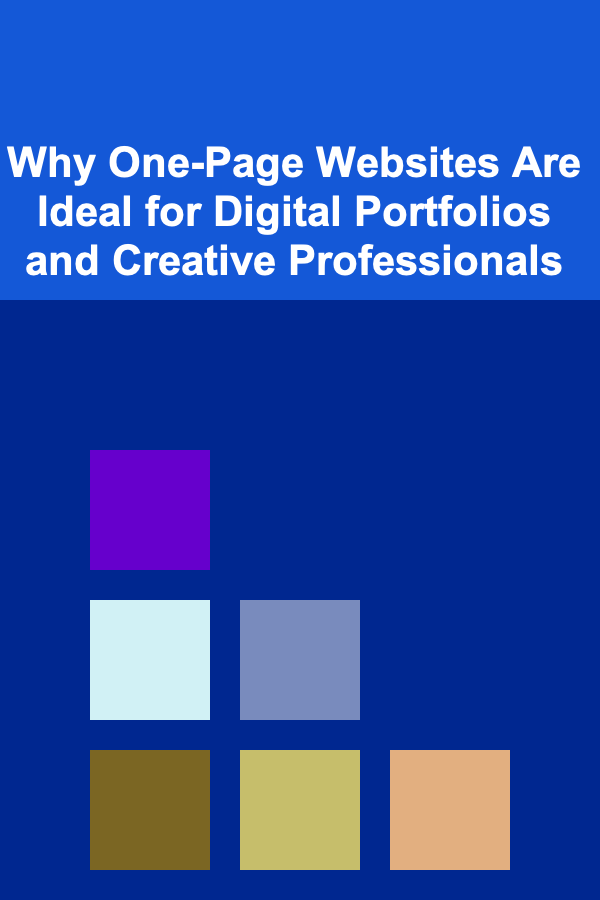
Why One-Page Websites Are Ideal for Digital Portfolios and Creative Professionals
ebook include PDF & Audio bundle (Micro Guide)
$12.99$11.99
Limited Time Offer! Order within the next:

In the modern digital era, establishing a strong online presence has become a critical part of any professional's journey, especially for those in creative industries. Digital portfolios serve as a virtual showcase of skills, experience, and creativity. While there are many ways to create and present an online portfolio, the one-page website has emerged as a particularly effective and popular choice for creative professionals.
This article delves into the reasons why one-page websites are ideal for digital portfolios and creative professionals, exploring their advantages in terms of user experience, simplicity, visual appeal, and functionality. By the end, you'll understand why a one-page website is not just a design choice but a strategic decision for building a compelling, personal, and professional online presence.
The Rise of One-Page Websites
A one-page website is essentially a website that condenses all its content into a single, scrollable page. Unlike traditional multi-page websites, one-page websites rely on the seamless flow of information, with each section providing specific details about the individual or business.
In the past decade, one-page websites have grown in popularity due to the proliferation of mobile devices, the rise of minimalist design trends, and the increasing desire for a more direct and engaging user experience. Creative professionals, from designers and photographers to writers and artists, have found one-page websites to be an effective platform to showcase their work, as they can focus the user's attention on their best projects and skills without overwhelming them with excessive navigation or complicated site structures.
Simplicity and Focus
Streamlining Content Presentation
One of the main advantages of a one-page website is its inherent simplicity. A one-page layout forces the website owner to prioritize their content, ensuring that only the most relevant and impactful information is presented. This can be especially beneficial for creative professionals who need to distill their work into a compelling narrative that is easy to digest and aesthetically pleasing.
Instead of overwhelming visitors with a multitude of pages filled with lengthy descriptions or numerous galleries, a one-page website allows professionals to focus on their best work, offering a concise overview of their skills, experience, and portfolio. The result is a clean, organized, and user-friendly experience, where visitors can quickly understand the individual's capabilities and talents without unnecessary distractions.
Simplified User Experience
A key consideration for digital portfolios is the user experience (UX). With one-page websites, users don't have to navigate through multiple pages or click on various links to view the portfolio. This means there is no chance of visitors getting lost or distracted.
The structure of a one-page website is simple and linear. Visitors scroll down the page, effortlessly moving from one section to the next. Whether they're looking at a project gallery, reading a bio, or checking out testimonials, everything is contained in a single view. This smooth flow of information reduces friction in the user journey and makes the site much easier to navigate compared to traditional websites with multiple pages.
Additionally, this simplicity can increase engagement. Visitors are more likely to stay longer on a site that's easy to navigate and doesn't require them to click through a series of pages to find what they're looking for. This can lead to higher conversion rates, whether the goal is to gain clients, secure job opportunities, or simply raise awareness.
Visual Impact
Design as a Showcase
For creative professionals, the visual presentation of their portfolio is often just as important as the work itself. A well-designed one-page website allows creatives to control every aspect of the site's appearance, using custom layouts, color schemes, typography, and imagery to reflect their personal style and aesthetic.
One-page websites can showcase design projects, photography portfolios, or writing samples in a way that is visually engaging without the constraints of traditional web design. By incorporating stunning visuals into the page's background, sections, and transitions, creative professionals can create a site that becomes a representation of their work and their brand.
Furthermore, one-page websites often feature interactive elements such as hover effects, smooth scroll animations, and parallax scrolling, which can add an extra layer of dynamism and sophistication to the user experience. These engaging features help keep visitors interested and reflect the skill set of the creative professional.
Maintaining Visual Consistency
Because all content is placed on a single page, designers and artists can maintain a consistent visual flow throughout the site. There is no risk of mismatched page designs or jarring transitions between different sections, as everything is carefully curated to complement one another. This consistent design aesthetic ensures that visitors experience a cohesive and harmonious journey through the website.
For example, a graphic designer may create custom illustrations that appear as part of the navigation, while a photographer may use high-quality images that fill the background and complement the content. The result is a polished, curated experience that showcases the professional's work in the best light.
Mobile Optimization
The one-page website format is especially conducive to mobile optimization. Given the growing importance of mobile browsing, it is crucial that digital portfolios look great and function seamlessly on smartphones and tablets. A one-page website's scrolling format is perfectly suited to mobile devices, where users can easily swipe through content without having to click through different links or pages.
Creative professionals benefit from this responsiveness because their portfolios will be easily accessible on all devices, reaching a wider audience. Whether clients or employers are browsing from their desktop or phone, the visual presentation and usability remain consistent, making the portfolio more appealing and easier to navigate.
Speed and Efficiency
Fast Loading Times
Another significant benefit of one-page websites is their typically faster loading times compared to multi-page sites. With fewer files, images, and scripts to load, one-page websites tend to have smaller file sizes and, as a result, faster load times. This can be particularly advantageous for creative professionals who need to capture a visitor's attention quickly.
Visitors are less likely to abandon a website that loads quickly, and this is especially important when showcasing visual work such as photography, design, or art. Slow-loading pages can be a huge turn-off, causing potential clients or employers to leave before fully experiencing the portfolio. One-page websites eliminate this concern by simplifying the design and streamlining content, ensuring a smooth and efficient browsing experience.
Higher Conversion Rates
By focusing on a single page, the call to action (CTA) can be much more direct. Whether it's scheduling a consultation, signing up for a newsletter, or contacting the professional, the CTA can be placed at multiple points throughout the page, increasing the chances of conversion. One-page websites are ideal for driving specific actions because there is a clear path for users to follow, without the distraction of extra pages or links.
For example, a creative professional may have a clear "Contact Me" button at the top and bottom of their page, allowing visitors to easily reach out. Since there are fewer barriers between the visitor and the action they need to take, conversion rates can be significantly higher.
SEO Benefits
Improved Focused SEO
Search engine optimization (SEO) is vital for ensuring that digital portfolios reach a broad audience. One-page websites can be more easily optimized for specific keywords since all the content is concentrated in one place. There's no need to optimize multiple pages, which can be time-consuming and require careful coordination.
By using targeted keywords in the headings, subheadings, and meta descriptions, a one-page website can rank well for those specific terms. For instance, a photographer's one-page site might use keywords such as "NYC photographer," "event photography," or "professional photography portfolio," helping it appear in search results for these relevant terms.
Boosted User Engagement
Google and other search engines take user engagement metrics into account when ranking websites. Since one-page websites tend to keep users engaged with smooth scrolling, interactive elements, and minimal distractions, they can lead to lower bounce rates and longer session times. These positive user signals can help improve the website's SEO ranking.
Additionally, the simple structure of one-page websites makes it easier to create high-quality, relevant content that directly speaks to the visitor's interests and needs, further boosting SEO performance.
Cost and Maintenance Efficiency
Affordable and Low Maintenance
One-page websites are often less expensive to design and develop than multi-page websites, which require more content creation, design work, and coding. For creative professionals just starting out, this cost-effectiveness makes one-page websites an attractive option.
Furthermore, maintenance is simplified because there is only one page to update, reducing ongoing costs. Whether it's adding new projects, updating contact information, or changing a bio, a one-page website is much easier to manage than a traditional multi-page site.
Conclusion
One-page websites are an ideal solution for creative professionals looking to showcase their work in a concise, visually engaging, and user-friendly manner. Their simplicity, aesthetic flexibility, speed, and cost-effectiveness make them a popular choice for digital portfolios in fields such as design, photography, writing, and more.
By utilizing a one-page website, creative professionals can present their work in a polished, interactive way while ensuring that the user experience is seamless and straightforward. Whether you're looking to attract clients, impress potential employers, or simply share your creative journey, a one-page website offers the ideal platform to make a lasting impact.
In the fast-moving world of digital portfolios, the one-page website stands out as a powerful tool for showcasing talent and creativity with style, clarity, and impact.
Reading More From Our Other Websites
- [Home Holiday Decoration 101] How to Use Vintage Holiday Decor to Add Charm to Your Home
- [Home Soundproofing 101] How to Use Acoustic Panels to Soundproof Your Living Room
- [Home Soundproofing 101] How to Soundproof Your Home's Floors to Block Out Footsteps
- [Hiking with Kids Tip 101] How to Teach Kids Navigation Skills on Multi‑Day Hikes Without Using a GPS Device
- [Home Budget 101] How to Save on Utility Bills with Simple Home Adjustments
- [Personal Care Tips 101] How to Choose the Best Soap for Oily Skin?
- [Personal Finance Management 101] How to Use the Debt Avalanche Method to Pay Off Debt Faster
- [Home Lighting 101] How to Style Shelves with Accent Lighting
- [Home Storage Solution 101] How to Use Clear Storage Containers for Easy Access and Visibility
- [Home Staging 101] How to Stage Your Home's Exterior to Make a Great First Impression

How to Create a Positive Relationship with Your Tenants
Read More
How to Make Money Online as a Freelance Writer
Read More
How To Regrout Bathroom Tiles
Read More
How to Set Up Automated Payments for Your Home Rental Property
Read More
How to Teach Your Dog to Walk on a Leash
Read More
How to Choose the Right Chiropractor for Your Specific Condition
Read MoreOther Products

How to Create a Positive Relationship with Your Tenants
Read More
How to Make Money Online as a Freelance Writer
Read More
How To Regrout Bathroom Tiles
Read More
How to Set Up Automated Payments for Your Home Rental Property
Read More
How to Teach Your Dog to Walk on a Leash
Read More